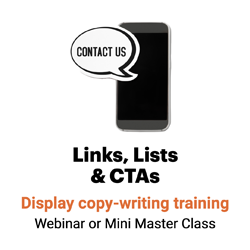11 tips for crafting a good list
Lists are power points in your content marketing pieces and on your webpages.

Here’s a list of ways to make the most of them:
1. Use more lists.
Review your site for places where a bulleted list would help visitors skim more easily. Then substitute lists for prose.
2. Organize lists logically.
Choose the right structure:
- Alphabetical structure is best for glossaries, for instance.
- Chronological structure is the right choice for a series of steps. [As everyone who’s ever put together an Ikea bedside table well knows.]
- Hierarchical structure works best for top 10 lists.
However, you’ll also want to …
3. Take advantage of the last item on the list.
The last element on a list often attracts more attention, says usability expert Jakob Nielsen:
- The first few items get the most attention.
- The middle items get less attention.
- The final item gets more attention than the one before it.
The serial item on a list may also benefit from the recency effect. This principle, coined by Hermann Ebbinghaus, says that items presented last will most likely be remembered best.
So if you’re creating a hierarchical list, consider an hourglass-shaped structure: Start with the most important items, bury the least important items in the middle, then end with the second- or third-most important item.
Get more tips on organizing your list.
4. Lead with the verb.
Do you have a list of instructions? Take a tip from my friends at LeasePlanUSA and lead with the verb:
Here are some tips for saving for the future.
This approach will help you …
5. Add a subhead to let readers know the topic of the list.
Visitors are looking for it, write Pernice, et al., authors of How People Read on the Web: The Eyetracking Evidence. “The eyes go almost instantly to the bulleted list, only stopping first to scan the bolded text above it.”
6. Make lists parallel.
One of the items on the LeasePlanUSA tipsheet is not like the others:
To keep your lists parallel, set up an intro line that says something like “To save for the future …” Then in your head, include that line before each bold-faced lead-in:
- [To save for the future,] Join …
- [To save for the future,] The tricky balance of paying off debt and saving for the future …
The first item works fine. The second does not. The fix? Rewrite to put the verb first:
- [To save for the future,] Balance paying off debt and saving for the future …
7. Don’t drop the bullets.
“The little dot on the left is an appealing element which immediately indicates that the item is a list,” Pernice, et al., write. Indeed, while people look at 70% of the lists with bullets they encounter, they look at only 55% of lists without bullets.
Get more tips on formatting your list.
8. Don’t repeat words.
Web visitors often bypass the first words in lists when they’re repeated. Reading the same thing over and over is a drag, and bypassing itself is a cognitive burden. Rewrite to avoid repetition.
9. Keep lists short.
Make them too long, and visitors will skim them in the F-shaped eye-gazing pattern.
Get more tips on the length of your list.
10. Make list items short.
“These are called ‘bulleted lists’ and not ‘bulleted paragraphs’ for a reason,” Pernice, et al., write. “Sticking a bullet in front of a paragraph is no good.”
11. Punctuate.
If yours is a list of sentences, add a period to the end of each. Otherwise, skip the punctuation. The bullets stand in for semicolons and commas separating items in your series.
___
Sources: Kara Pernice, Kathryn Whitenton, and Jakob Nielsen; How People Read on the Web: The Eyetracking Evidence; Nielsen Norman Group; Sept. 10, 2013

Leave a Reply